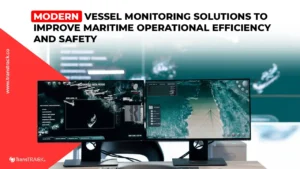Tips for Successful Fleet Management System Implementation and How it Works!
Posted on October 19, 2023 by Nur Wachda Mihmidati

Fleet Management Systems (FMS) are technology solutions that help businesses to optimize the management of their vehicle fleet, including cars, trucks, or other vehicles. The system uses technologies such as GPS, sensors, and software to track vehicle positions, monitor driver behavior, calculate distance and travel time, and manage vehicle maintenance.
In this article, we will discuss the use of a FMS, how the system works, and tips and tricks for successful implementation. The use of a FMS can help improve operational efficiency, reduce costs, and improve vehicle and driver safety. Check out the following TransTRACK article!
What is a Fleet Management System?
Fleet Management System is a system used to manage vehicle fleets, ranging from vehicle management, maintenance, supervision, driver management, to monitoring vehicle operations in business activities. This system can be used for private vehicles, company vehicles, or public vehicles such as taxis, buses, and trucks.
A Fleet Management System consists of software and hardware that work together to collect, store, and analyze data from vehicles in a fleet. The data collected includes information about vehicle position, speed, fuel consumption, vehicle usage, and other information that can help fleet managers make the right decisions.
By using a FMS, fleet managers can optimize vehicle usage, reduce operating costs, increase efficiency, improve service quality, and improve driver and passenger safety. The system can also help reduce the environmental impact of vehicle fleets, such as harmful exhaust emissions.
How does the Fleet Management System Work?
The FMS works by collecting and analyzing data obtained from vehicles in the fleet, and providing useful information to fleet managers. Here are some components and how the FMS works:
GPS Tracking
The system uses GPS to track the position of vehicles in real time. With GPS, fleet managers can monitor vehicle positions and routes taken, so as to improve vehicle usage and optimize routes taken.
Vehicle Sensors
The system uses sensors attached to the vehicle to collect data such as speed, fuel consumption, and vehicle usage. This information is used to monitor and improve vehicle performance, as well as estimate vehicle maintenance times.
Driver Management
The system can also monitor driver behavior such as speed, acceleration and braking. This information can be used to improve driving safety and efficiency.
Route Planning and Organization
This system can calculate the distance and travel time of a route and provide more efficient route suggestions.
Vehicle Maintenance Management
The system can monitor vehicle maintenance times such as oil changes, routine servicing, and vehicle repairs. This information is used to keep the vehicle in good condition and reduce maintenance costs.
Reporting and Analysis
The system provides complete information on fleet and driver performance, allowing fleet managers to make informed decisions based on data and analyze overall fleet performance.
By combining these technologies, the FMS can help fleet managers manage their fleets more effectively and efficiently, and improve driver and passenger safety.
Tips and Tricks for Successful Fleet Management System Implementation
Here are some tips and tricks that can help in the successful implementation of a FMS:
Needs Identification
Before starting the implementation of a FMS, identify the business and vehicle requirements. Consider the types of vehicles to be tracked, the types of data required, and the expected functions of the system.
Employee Training
Ensure that employees responsible for the use of the system are properly trained on how the system works, how to collect data, and how to analyze the information provided by the system. This will help optimize the use of the system and maximize the benefits of the system.
Vendor Selection
Choose a FMS vendor that has experience and a good reputation in installing and operating the system. Also make sure the vendor has adequate technical support and can provide good after-sales service.
Effective Communication
Provide clear and detailed information about the implementation of the Fleet Management System to all employees and relevant stakeholders. Communicate the benefits gained from the system and how to use the system properly.
Periodic System Evaluation
Conduct regular evaluations of the Fleet Management System used to ensure that the system is running well and providing the expected benefits. If problems or weaknesses are found in the system, fix them immediately so that the system can run optimally.
Phased Implementation
Implement the Fleet Management System in stages to reduce the impact on business operations. For example, start by installing the system on a few vehicles first and then slowly add other vehicles to the system.
By following these tips and tricks, the use of a Fleet Management System can help increase operational efficiency, reduce costs, and improve vehicle and driver safety.
Overall, Fleet Management System is a technology that is highly beneficial for businesses that manage a fleet of vehicles. By using this technology, businesses can monitor and manage their fleet effectively and efficiently. The benefits of using a Fleet Management System include increased operational efficiency, reduced costs, improved driver and vehicle safety, and increased customer satisfaction.
It is important to note that Fleet Management System implementation can be time-consuming and require significant investment. However, if done correctly, the implementation of this system can bring many benefits and long-term advantages to your business.
Finally, it is important to choose a Fleet Management System vendor that can provide adequate technical support and can provide good after-sales service. Periodic evaluation is also important to ensure that the system is running well and providing the expected benefits. By paying attention to these things, your business can successfully implement a Fleet Management System and improve its operational efficiency and productivity.
TransTRACK’s Fleet Management System also has excellent features. You can use TransTRACK’s FMS to experience the features of Monitor Driver Behavior, Manage Vehicles and Drivers, Improve Fuel Efficiency, Optimize Vehicle Routes, Improve Vehicle Utility and Safety, Real Time Tracking, and Accident Compensation. Start using TransTRACK for your best fleet management!
Recent Post
Topic :
Recommended Articles

 Bahasa Indonesia
Bahasa Indonesia








